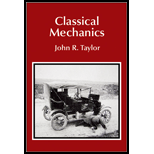
(a)
The equations for the velocity and position of a dropped object subjected to quadratic air resistance.
(a)
Answer to Problem 2.35P
The equations for the velocity and position of a dropped object subjected to quadratic air resistance are
Explanation of Solution
Write the equation of motion of a baseball dropped from a window in a high tower.
Here,
When ball reaches terminal velocity the velocity of the ball will be zero.
Substitute,
Substitute,
Rewrite equation (II).
Integrate equation (III) on both sides to obtain
Substitute,
Substitute,
Substitute,
Integrate equation (VII) on both sides to get
Substitute,
Conclusion:
Therefore, the equations for the velocity and position of a dropped object subjected to quadratic air resistance are
(b)
Show that when
(b)
Answer to Problem 2.35P
It is show that when
Explanation of Solution
Substitute,
Substitute,
Thus, when
Substitute,
Thus, when
Substitute,
Thus, when
Conclusion:
Therefore, it is show that when
(c)
Show that when
(c)
Answer to Problem 2.35P
It is shown that when
Explanation of Solution
When
As
Substitute,
Simplify equation (XI).
Conclusion:
Therefore, it is shown that when
(d)
Show that when
(d)
Answer to Problem 2.35P
It is shown that when
Explanation of Solution
According to Taylor series
Substitute,
Since
Take logarithm on both sides of the equation (XII).
According to Taylor series expansion.
Apply the above Taylor series in equation (XIII).
Neglect
Substitute, equation (XV) in (IX).
Conclusion:
Therefore, It is shown that when
Want to see more full solutions like this?
Chapter 2 Solutions
Classical Mechanics
 College PhysicsPhysicsISBN:9781305952300Author:Raymond A. Serway, Chris VuillePublisher:Cengage Learning
College PhysicsPhysicsISBN:9781305952300Author:Raymond A. Serway, Chris VuillePublisher:Cengage Learning University Physics (14th Edition)PhysicsISBN:9780133969290Author:Hugh D. Young, Roger A. FreedmanPublisher:PEARSON
University Physics (14th Edition)PhysicsISBN:9780133969290Author:Hugh D. Young, Roger A. FreedmanPublisher:PEARSON Introduction To Quantum MechanicsPhysicsISBN:9781107189638Author:Griffiths, David J., Schroeter, Darrell F.Publisher:Cambridge University Press
Introduction To Quantum MechanicsPhysicsISBN:9781107189638Author:Griffiths, David J., Schroeter, Darrell F.Publisher:Cambridge University Press Physics for Scientists and EngineersPhysicsISBN:9781337553278Author:Raymond A. Serway, John W. JewettPublisher:Cengage Learning
Physics for Scientists and EngineersPhysicsISBN:9781337553278Author:Raymond A. Serway, John W. JewettPublisher:Cengage Learning Lecture- Tutorials for Introductory AstronomyPhysicsISBN:9780321820464Author:Edward E. Prather, Tim P. Slater, Jeff P. Adams, Gina BrissendenPublisher:Addison-Wesley
Lecture- Tutorials for Introductory AstronomyPhysicsISBN:9780321820464Author:Edward E. Prather, Tim P. Slater, Jeff P. Adams, Gina BrissendenPublisher:Addison-Wesley College Physics: A Strategic Approach (4th Editio...PhysicsISBN:9780134609034Author:Randall D. Knight (Professor Emeritus), Brian Jones, Stuart FieldPublisher:PEARSON
College Physics: A Strategic Approach (4th Editio...PhysicsISBN:9780134609034Author:Randall D. Knight (Professor Emeritus), Brian Jones, Stuart FieldPublisher:PEARSON





